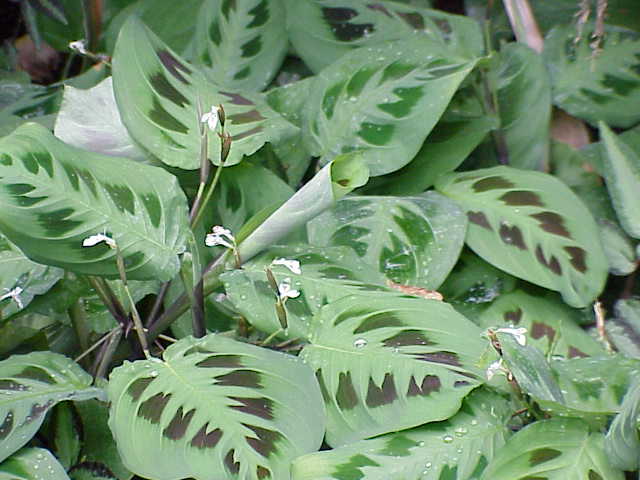Do you have a cat in your house that loves to explore and get into all sorts of mischief? If so, you may have noticed that they often go after plants, hoping to find something to snack on or just something to play with. It can be a bit nerve-wracking when you find them snacking on a plant you don’t recognize, but some plants can be surprisingly safe for cats – like prayer plants. Prayer plants are not only beautiful, but they are also non-toxic for cats. Having these plants in your house can be a great way to keep your cat safe, without sacrificing your decor. So let’s take a look at why prayer plants are an ideal choice for pet owners who want to keep their cats safe.
Prayer plants are non-toxic for cats according the ASPCA. Consuming anything out of the norm can be hard on your cat’s digestion though. If you are concerned, consult a local veterinarian.

Image credit: Kurt Stüber; Image licence: CC BY-SA 3.0
What is a Prayer Plant?
But what is a prayer plant, you might ask? Well, prayer plants are a type of houseplant that contains a unique feature which sets them apart from other plants – their leaves are able to fold and unfold depending on the amount of light they receive. During the day, the leaves will fold up and look like hands praying, and at night the leaves will unfold and open up. This unique feature of the prayer plant has made it a popular choice for many homeowners.
Another great benefit of keeping prayer plants in the house is that, unlike other plants, they are non-toxic for cats, making them a great choice for households with furry family members. In addition to being safe for cats, prayer plants also require very little maintenance, making them a perfect choice for busy cat parents who don’t have a lot of time to devote to caring for plants.
Not only are prayer plants a safe and easy way to add some greenery to your home, they are also believed to have calming and soothing properties that can help to create a more peaceful environment for both cats and humans alike. So if you’re looking for a way to create a safe and peaceful home for your cat, consider adding some prayer plants to your decor.
How to Care for a Prayer Plant
I’ve been keeping prayer plants around the house for a few years now, and I’ve come to appreciate their calming presence, as well as the added benefit of being non-toxic for my cat. Caring for a prayer plant is a simple process, but one that requires some extra attention if you want it to thrive in your home.
First, you’ll need to make sure your prayer plant is getting enough light. They do best in bright, indirect sunlight, which can be hard to find in some homes. If you don’t have a lot of natural light, you can supplement with a grow light. You’ll also want to make sure the soil your plant is in is moist but not soggy, as too much water can cause the leaves to turn yellow. I like to use a spray bottle to mist the leaves once a week, as this will help keep the soil moist without overwatering.
Finally, you’ll need to make sure your prayer plant is getting enough fertilizer. A diluted liquid fertilizer applied once a month should do the trick. This is especially important if you’re using a grow light, as it will help ensure your plant is getting the nutrients it needs to stay healthy. As with any plant, it’s important to keep an eye on your prayer plant and take note of any changes in color, texture, or growth. Catching an issue early can help you save your plant and keep it looking its best.
Protecting your plants (and pets)
When it comes to keeping cats from damaging plants, one of the most important steps is to create a safe and structured environment for the cat. This means keeping the cat away from plants, where it can’t knock them over, or use them as a scratching post or chew toy. If the plant is kept in an area the cat has access to you can try to keep it out of reach.
Another tip is to provide plenty of other outlets for the cat’s curiosity. Make sure the cat has plenty of toys to play with, and give it plenty of attention and affection. If cats feel that they are getting enough stimulation, they are less likely to be tempted to damage plants.
Finally, if your cat does start to damage the plants, it’s important not to react with anger or aggression. Instead, try to redirect the cat’s attention away from the plants. If the cat is scratching a plant, try to distract it (but don’t reward it)!
I try to keep something more interesting or appealing near my plants. In the case of scratching, I put quality scratching posts wherever my cats want to scratch – whether that is by the couch or by an indoor tree! DIY or buy one that suits your decor.
Enjoying plants as a cat owner
I love having plants in my home along with my cats. It’s not only aesthetically pleasing to have a variety of vegetation, but I get health benefits from it as well. Plants help to filter the air and can reduce airborne toxins, which helps keep us breathing easier. They regulate humidity. Plus they create a calming atmosphere that is perfect for mental wellness, reducing stress and promoting mindfulness.
Having indoor plants helps bring me peace throughout the day. Whenever I’m feeling overwhelmed or anxious, taking care of my potted friends provides an escape from reality that allows me to become one with nature despite being stuck inside four walls all day long. My cats benefit from personal cat television watching me work or enjoying the movement of leaves when there’s a breeze.
If you want to expand your plant repertoire check out other pet-safe options such as spider plants or dried pampas grass.
